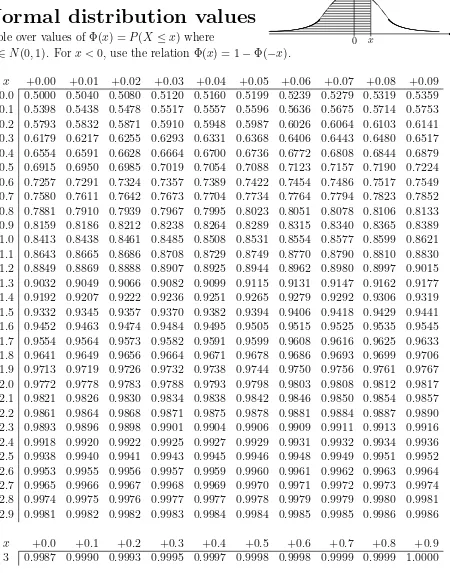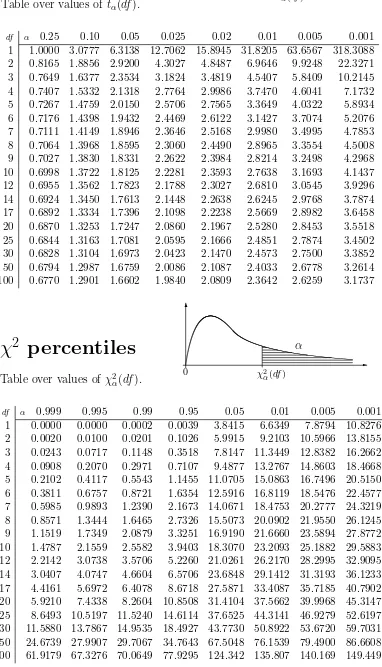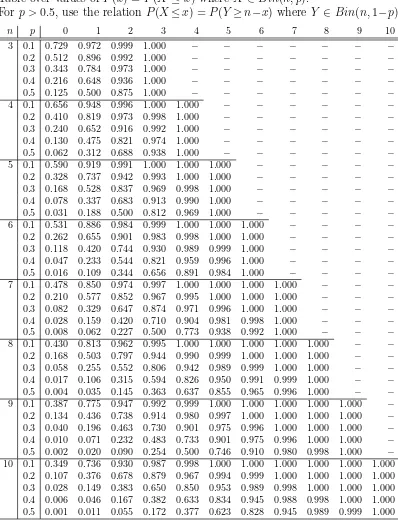MA8017 Engineering Mathematics Halmstad University
Some rules of Probability and Statistics
Def If an experiment hasm outcomes of whichb results in the event A, then the probability of A is
P(A) = g/m .
Def P is a probability measure if 1. 0≤P(A)≤1
2. P(Ω) = 1
3. A∩B =∅ ⇒ P(A∪B) = P(A) +P(B) for all eventsA ⊂Ω where Ω is the sample space.
Basic principle If an experiment can be divided into j subexperiments where the of counting first hasn1 outcomes
second has n2 outcomes ...
jth has nj outcomes
then the experiment totally has n1·n2· · ·nj outcomes.
Addition theorem P(A∪B) = P(A) +P(B)−P(A∩B).
Def A and B are independent events if P(A∩B) = P(A)P(B)
Def The conditional probability ofA givenB is P(A|B) = P(A∩B)
P(B)
Bayes theorem If A1, . . . , An is a partition of Ω (i.e. i6=j ⇒Ai∩Aj =∅ and Sn
i=1Ai = Ω).
then P(Ak|B) = PnP(B|Ak)P(Ak)
i=1P(B|Ai)P(Ai)
for each k = 1,2, . . . , n.
Combinatorics The number of ways to choosek elements amongn possible, without replacement and without respect to the order, is
n k
= n!
k! (n−k)! =
n(n−1)· · ·(n−k+ 1)
Random X discrete: Probability fcn: p(x) = P(X =x)
variables Distribution fcn: P(X ≤a) = F(a) = P
x≤ap(x),
X cont.: Density fcn: f(x) = dxdP(X ≤x) Distribution fcn: P(X ≤a) = F(a) = Ra
−∞f(x)dx.
Expected value X discrete: The expected value of X: µ=E(X) = P
x∈Ωx p(x).
and variance Variance of X: σ2 =V(X) = P
x∈Ω(x−µ)2p(x).
X cont: Expected value of X: µ=E(X) = R
x∈Ωx f(x)dx. Variance of X: σ2 =V(X) = R
x∈Ω(x−µ)
2f(x)dx.
Covariance of X and Y: C(X, Y) = E((X−µx)(Y −µy)) Correlation of X and Y: ρ = √C(X,Y)
V(X)V(Y) Standarddev. σ = p
V(X).
Linearity: E(aX+bY) = a E(X) +b E(Y) for all random variables X and Y and real numbers a and b.
IfX, Y indep. then V(aX+bY) = a2V(X) +b2V(Y). Rules: E(g(X)) = R
Rg(x)f(x)dx
V(X) = E(X2)−(E(X))2
C(X, Y) = R R
R2xy f(x, y)−E(X)E(Y) C(P
iaiXi,
P
kbkYk) =
P
i
P
kaibkC(Xi, Yk)
Normal denoted by N(µ, σ2) whereµ is the expected value andσ2 is the variance distributionN(0,1) is called standard normal distribution with density function Φ(x)
If X ∈N(µ, σ2) thenP(X ≤x) = Φ x−µ σ
Symmetry: Φ(−x) = 1−Φ(x)
Probabilities: P(a ≤X ≤b) = Φ b−σµ
−Φ a−σµ
Def The random variables X1, X2, . . . , Xn are a sample ofX if all variables, Xi, is distributed asX, i= 1, . . . , n, and all variables are independent of
each other at all levels.
CLT (Central Limit Theorem)
If X1, . . . , Xn is a sample where
E(Xi) =µ and V(Xi) = σ2,i= 1, . . . , n
then P√σn( ¯X−µ)≤x → Φ(x) as n→ ∞. This implies that Pn
i=1Xi is approximately N(nµ, nσ2)
and ¯X is approximately N(µ, σ2/n) for largen.
Approximations Distribution Condition Approximative distribution
Bin(n, π) n ≥10 andπ <0.1 P o(nπ)
Bin(n, p) np(1−p)≥10 N(np, np(1−p))
Def {Xt}={Xt:t ∈T ⊆R} is a random process if all variables Xt, t∈T have the same probability distribution regardless of t. T is called index space.
Thm If {Xt} has independent, stationary increments and X0 = 0 then rX(s, t) = min(s, t)·V(X1).
Relationship between cvf, r(τ), and spectral density,R(f),
Continuous time Discrete time
If {Xt} is a random process which is sampled into {Yk}={Xkd :k = 0,±1,±2, . . .} (normed frequency)
If {Xt} is the shot-noise process with parameter λ and pulse-function g(s)
Relation to cvf
Relation between spectral density and transfer function
RY(f) =|H(f)|2RX(f)
Def White noise in discrete time is an independent sequence {ǫt}∞
Def The cross covariance of {Xt} and {Yt} is denoted by rX,Y(τ) and defined by rX,Y(τ) = C(Xt, Yt+τ) =
R Re
i2πf τRX,Y(f)df
Derivative process
Thm IfrX′′(τ) exists then {Xt′} exists and then
rX′(τ) = −rX′′(τ) RX′(f) = (2πf)2RX(f) rX,X′(τ) =rX′ (τ)
Inference
Thm (Estimation of expected value)
If mˆn= 1nPnt=1Xt
then V( ˆmn) = n12
Pn−1
k=−n+1(n− |k|)rX(k)
nV( ˆmn)≈P∞
k=−∞rX(k) for largen
Thm (Estimation of cvf and periodogram)
If m is known
then an unbiased estimator of rX(τ) is ˆ
rn(τ) = n1 Pn−τ
t=1(Xt−m)(Xt+τ −m) for τ ≥0
If zn(f) = Pnt=0−1Xte−i2πf t
then ˆRper(f) = n1|zn(f)|2 E( ˆRper(f)) =P
|τ|<ne−i2πf τ(1− | τ|
n)rX(τ)
V( ˆRper(f))≈ (
R(f)21 +nsin 2sin 2πnfπf2 for 0<|f|< 12
R(f)2 for f = 0,±1
2
C( ˆRper(f), Rperˆ (f′)) → 0 for f 6=f′ as n→ ∞
2 ˆRper(f)/R(f) is approxiamtelyχ2(2) distributed for 0< f < 1 2
Thm (Time and frequency window)
kn(τ) =k(τ /Ln)
K(f) =R1 −1e
i2πf τk(τ)dτ
Kn(f) =PLn
τ=−Lne
i2πf τkn(τ)≈LnK(f Ln)
(Smoothed periodogram) ˆ
R(f) =PLn
τ=−Lne
i2πf τkn(τ)ˆrn(τ)
E( ˆR(f))≈LnR1/2
−1/2K((x−f)Ln)dx(≈R(f) if Ln is large)
V( ˆR(f)) = Ln
n R(f)2
R1
Point estimation If E(X) = µ, V(X) = σ2 and X
1, . . . , Xn is a sample of X then exampels of point estimators of µand σ2 are:
ˆ
1 and θ∗2 are unbiased estimators of θ, then θ∗1 is better/more efficient than
Normal distribution values
✻
✲ ✓
✓ ❙❙
x
0 Φ(x)
Table over values of Φ(x) =P(X ≤x) where
X ∈N(0,1). For x <0, use the relation Φ(x) = 1−Φ(−x).
x +0.00 +0.01 +0.02 +0.03 +0.04 +0.05 +0.06 +0.07 +0.08 +0.09 0.0 0.5000 0.5040 0.5080 0.5120 0.5160 0.5199 0.5239 0.5279 0.5319 0.5359 0.1 0.5398 0.5438 0.5478 0.5517 0.5557 0.5596 0.5636 0.5675 0.5714 0.5753 0.2 0.5793 0.5832 0.5871 0.5910 0.5948 0.5987 0.6026 0.6064 0.6103 0.6141 0.3 0.6179 0.6217 0.6255 0.6293 0.6331 0.6368 0.6406 0.6443 0.6480 0.6517 0.4 0.6554 0.6591 0.6628 0.6664 0.6700 0.6736 0.6772 0.6808 0.6844 0.6879 0.5 0.6915 0.6950 0.6985 0.7019 0.7054 0.7088 0.7123 0.7157 0.7190 0.7224 0.6 0.7257 0.7291 0.7324 0.7357 0.7389 0.7422 0.7454 0.7486 0.7517 0.7549 0.7 0.7580 0.7611 0.7642 0.7673 0.7704 0.7734 0.7764 0.7794 0.7823 0.7852 0.8 0.7881 0.7910 0.7939 0.7967 0.7995 0.8023 0.8051 0.8078 0.8106 0.8133 0.9 0.8159 0.8186 0.8212 0.8238 0.8264 0.8289 0.8315 0.8340 0.8365 0.8389 1.0 0.8413 0.8438 0.8461 0.8485 0.8508 0.8531 0.8554 0.8577 0.8599 0.8621 1.1 0.8643 0.8665 0.8686 0.8708 0.8729 0.8749 0.8770 0.8790 0.8810 0.8830 1.2 0.8849 0.8869 0.8888 0.8907 0.8925 0.8944 0.8962 0.8980 0.8997 0.9015 1.3 0.9032 0.9049 0.9066 0.9082 0.9099 0.9115 0.9131 0.9147 0.9162 0.9177 1.4 0.9192 0.9207 0.9222 0.9236 0.9251 0.9265 0.9279 0.9292 0.9306 0.9319 1.5 0.9332 0.9345 0.9357 0.9370 0.9382 0.9394 0.9406 0.9418 0.9429 0.9441 1.6 0.9452 0.9463 0.9474 0.9484 0.9495 0.9505 0.9515 0.9525 0.9535 0.9545 1.7 0.9554 0.9564 0.9573 0.9582 0.9591 0.9599 0.9608 0.9616 0.9625 0.9633 1.8 0.9641 0.9649 0.9656 0.9664 0.9671 0.9678 0.9686 0.9693 0.9699 0.9706 1.9 0.9713 0.9719 0.9726 0.9732 0.9738 0.9744 0.9750 0.9756 0.9761 0.9767 2.0 0.9772 0.9778 0.9783 0.9788 0.9793 0.9798 0.9803 0.9808 0.9812 0.9817 2.1 0.9821 0.9826 0.9830 0.9834 0.9838 0.9842 0.9846 0.9850 0.9854 0.9857 2.2 0.9861 0.9864 0.9868 0.9871 0.9875 0.9878 0.9881 0.9884 0.9887 0.9890 2.3 0.9893 0.9896 0.9898 0.9901 0.9904 0.9906 0.9909 0.9911 0.9913 0.9916 2.4 0.9918 0.9920 0.9922 0.9925 0.9927 0.9929 0.9931 0.9932 0.9934 0.9936 2.5 0.9938 0.9940 0.9941 0.9943 0.9945 0.9946 0.9948 0.9949 0.9951 0.9952 2.6 0.9953 0.9955 0.9956 0.9957 0.9959 0.9960 0.9961 0.9962 0.9963 0.9964 2.7 0.9965 0.9966 0.9967 0.9968 0.9969 0.9970 0.9971 0.9972 0.9973 0.9974 2.8 0.9974 0.9975 0.9976 0.9977 0.9977 0.9978 0.9979 0.9979 0.9980 0.9981 2.9 0.9981 0.9982 0.9982 0.9983 0.9984 0.9984 0.9985 0.9985 0.9986 0.9986
x +0.0 +0.1 +0.2 +0.3 +0.4 +0.5 +0.6 +0.7 +0.8 +0.9 3 0.9987 0.9990 0.9993 0.9995 0.9997 0.9998 0.9998 0.9999 0.9999 1.0000
Percentiles:
α λα α λαt
percentiles
✻
✲
tα(df) 0
α
Table over values of tα(df).
df α 0.25 0.10 0.05 0.025 0.02 0.01 0.005 0.001
1 1.0000 3.0777 6.3138 12.7062 15.8945 31.8205 63.6567 318.3088 2 0.8165 1.8856 2.9200 4.3027 4.8487 6.9646 9.9248 22.3271 3 0.7649 1.6377 2.3534 3.1824 3.4819 4.5407 5.8409 10.2145 4 0.7407 1.5332 2.1318 2.7764 2.9986 3.7470 4.6041 7.1732 5 0.7267 1.4759 2.0150 2.5706 2.7565 3.3649 4.0322 5.8934 6 0.7176 1.4398 1.9432 2.4469 2.6122 3.1427 3.7074 5.2076 7 0.7111 1.4149 1.8946 2.3646 2.5168 2.9980 3.4995 4.7853 8 0.7064 1.3968 1.8595 2.3060 2.4490 2.8965 3.3554 4.5008 9 0.7027 1.3830 1.8331 2.2622 2.3984 2.8214 3.2498 4.2968 10 0.6998 1.3722 1.8125 2.2281 2.3593 2.7638 3.1693 4.1437 12 0.6955 1.3562 1.7823 2.1788 2.3027 2.6810 3.0545 3.9296 14 0.6924 1.3450 1.7613 2.1448 2.2638 2.6245 2.9768 3.7874 17 0.6892 1.3334 1.7396 2.1098 2.2238 2.5669 2.8982 3.6458 20 0.6870 1.3253 1.7247 2.0860 2.1967 2.5280 2.8453 3.5518 25 0.6844 1.3163 1.7081 2.0595 2.1666 2.4851 2.7874 3.4502 30 0.6828 1.3104 1.6973 2.0423 2.1470 2.4573 2.7500 3.3852 50 0.6794 1.2987 1.6759 2.0086 2.1087 2.4033 2.6778 3.2614 100 0.6770 1.2901 1.6602 1.9840 2.0809 2.3642 2.6259 3.1737
χ
2
percentiles
✲ ✻
χ2α(df)
0
α
Table over values of χ2
α(df).
Values of the Poisson distribuion
Table over values of F(x) =P(X ≤x) whereX ∈P o(λ).
λ 0 1 2 3 4 5 6 7 8 9 10 11 12 13
0.5 0.607 0.910 0.986 0.998 1.000 1.000 1.000 1.000 1.000 1.000 1.000 1.000 1.000 1.000 1 0.368 0.736 0.920 0.981 0.996 0.999 1.000 1.000 1.000 1.000 1.000 1.000 1.000 1.000 2 0.135 0.406 0.677 0.857 0.947 0.983 0.995 0.999 1.000 1.000 1.000 1.000 1.000 1.000 3 0.050 0.199 0.423 0.647 0.815 0.916 0.966 0.988 0.996 0.999 1.000 1.000 1.000 1.000 4 0.018 0.092 0.238 0.433 0.629 0.785 0.889 0.949 0.979 0.992 0.997 0.999 1.000 1.000 5 0.007 0.040 0.125 0.265 0.440 0.616 0.762 0.867 0.932 0.968 0.986 0.995 0.998 0.999 6 0.002 0.017 0.062 0.151 0.285 0.446 0.606 0.744 0.847 0.916 0.957 0.980 0.991 0.996
Values of the Binomial distribution
Table over values of P(x) =P(X ≤x) whereX ∈Bin(n, p).
Forp > 0.5, use the relationP(X≤x) = P(Y ≥n−x) whereY ∈Bin(n,1−p).
n p 0 1 2 3 4 5 6 7 8 9 10
3 0.1 0.729 0.972 0.999 1.000 − − − − − − − 0.2 0.512 0.896 0.992 1.000 − − − − − − − 0.3 0.343 0.784 0.973 1.000 − − − − − − − 0.4 0.216 0.648 0.936 1.000 − − − − − − − 0.5 0.125 0.500 0.875 1.000 − − − − − − − 4 0.1 0.656 0.948 0.996 1.000 1.000 − − − − − −
0.2 0.410 0.819 0.973 0.998 1.000 − − − − − −
0.3 0.240 0.652 0.916 0.992 1.000 − − − − − −
0.4 0.130 0.475 0.821 0.974 1.000 − − − − − −
0.5 0.062 0.312 0.688 0.938 1.000 − − − − − −
5 0.1 0.590 0.919 0.991 1.000 1.000 1.000 − − − − − 0.2 0.328 0.737 0.942 0.993 1.000 1.000 − − − − − 0.3 0.168 0.528 0.837 0.969 0.998 1.000 − − − − − 0.4 0.078 0.337 0.683 0.913 0.990 1.000 − − − − − 0.5 0.031 0.188 0.500 0.812 0.969 1.000 − − − − − 6 0.1 0.531 0.886 0.984 0.999 1.000 1.000 1.000 − − − − 0.2 0.262 0.655 0.901 0.983 0.998 1.000 1.000 − − − − 0.3 0.118 0.420 0.744 0.930 0.989 0.999 1.000 − − − − 0.4 0.047 0.233 0.544 0.821 0.959 0.996 1.000 − − − − 0.5 0.016 0.109 0.344 0.656 0.891 0.984 1.000 − − − − 7 0.1 0.478 0.850 0.974 0.997 1.000 1.000 1.000 1.000 − − −
0.2 0.210 0.577 0.852 0.967 0.995 1.000 1.000 1.000 − − −
0.3 0.082 0.329 0.647 0.874 0.971 0.996 1.000 1.000 − − −
0.4 0.028 0.159 0.420 0.710 0.904 0.981 0.998 1.000 − − −
0.5 0.008 0.062 0.227 0.500 0.773 0.938 0.992 1.000 − − −
Trigonometrics
The Fourier transform ofg The inverse Fourier transform of G


